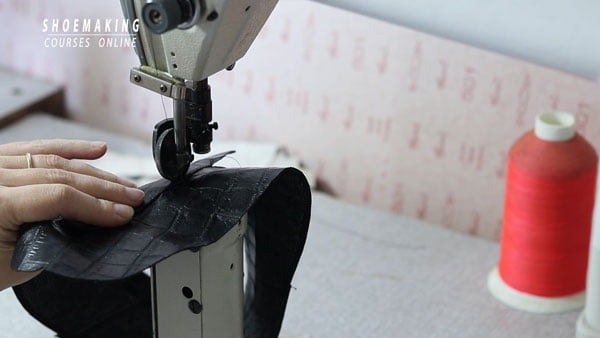Postbed sewing machines
A postbed sewing machine is characterized by its elevated, cylindrical sewing surface, or "post."

This sewing machine allows for greater maneuverability when sewing around edges, corners, or on three-dimensional items like shoes and bags. The raised post provides the ability to sew in hard-to-reach areas, making it particularly advantageous for detailed work or complex assemblies. Commonly used in the footwear and leather industries, the postbed machine is essential when precision and flexibility are required in stitching.
Pfaff postbed sewing machine
Pfaff 591
Renowned for its versatility and precision, this machine has a high post-bed design. It's often used in leather goods manufacturing, especially for operations that require detailed work.
Pfaff 491
This machine is known for its precision and versatility, making it a suitable choice for leather sewing, especially in intricate work.
Pfaff 492
This model is also a post-bed mac Application: Like the 491, the 492 is commonly used in leather goods manufacturing, especially for intricate operations that require detailed work.
Pfaff 1291
An older model but a reliable post-bed machine suitable for detailed leatherwork.
Singer postbed sewing machine
Singer 51w
This is an older, but trusted, post-bed machine often used in the shoe and leather goods industry. Given its design, it's suitable for intricate work on products like shoes and bags.
Singer 51w55
An iteration within the 51w series, this model is another post-bed machine designed for detailed leatherwork, especially in the shoe industry.
Singer 29K
While this might be considered a cylinder arm by some due to its unique design, its principle is somewhat similar to post-bed machines, with a raised working area. The 29K is a classic patcher machine, known for its ability to sew in any direction and is often used for shoe repairs and other detailed leatherwork.
COBRA postbed sewing machine
COBRA Class 14
Designed for detailed work in leather. The post-bed design is great for sewing in confined spaces and reaching tighter areas of a project, such as corners and curves of shoes, boots, and other three-dimensional products. It works well with both medium and some heavier leathers, like the one that we used to create these Dr. Martens Boots, which need to be made of robust and thick leather.
COBRA Class 5110
A versatile post-bed machine built for precision and ease of use. Its post-bed design allows for enhanced maneuverability, especially for intricate leatherwork, including the curves and seams of shoes and other leather items.
COBRA Class 5550HP
Known for its durability and efficiency, this model is well-suited for a range of leather goods, including shoes. Its design prioritizes precision stitching, making it suitable for both simple and intricate leather projects.
COBRA Class 26
A cylinder arm machine, not a flat bed, but still worth mentioning. It's a compact machine designed for crafting items like shoes, purses, and bags. The cylinder arm makes it especially suitable for round or tubular items and tight corners.Other brands of postbed sewing machines
Seiko LPW Series
The Seiko LPW series offers a range of post-bed machines, many of which are optimized for leatherwork, especially for shoe manufacturing.
Highlead GC2698-1
This machine has a high post bed and a compound feed mechanism, making it especially suitable for sewing thicker materials, including leather.
Durkopp Adler 888
Designed specifically for the shoe industry, this post-bed machine offers excellent precision and durability for leatherwork.
Global BP 341
A versatile post-bed machine, this model from Global is known for its ability to handle leather and other thick materials with ease.
When considering a post-bed machine for leatherwork, especially if for commercial or industrial use, it's essential to test the machine with the specific type of leather you plan to use. Ensure it can handle the thickness and offers the precision you need. It's also important to regularly maintain and service these machines to ensure consistent performance when working with tough materials like leather.
Remember that while many of these machines can handle leather, they may not be designed for extremely thick or hard types of leather, so always ensure the machine is suitable for the specific tasks you have in mind.

Suggestions for beginners in shoemaking
Drawing from my personal experience in the world of shoemaking, I strongly recommend beginners to consider investing in older, used sewing machines. These can often be procured locally at a fraction of the cost of new models, yet they deliver exceptional performance. Renowned brands such as Pfaff and Singer have stood the test of time, producing machines that are durable, reliable, and tailor-made for intricate tasks like shoemaking. I've included these tried-and-true machines in the list provided, ensuring that you'll find an outstanding sewing machine that suits your needs without breaking the bank.
Remember , when looking at older Singer or Pfaff models (or any older industrial machines), it's important to consider their condition. Older machines that have been well-maintained or properly restored can be exceptional workhorses. Always test the machine with the specific leather material you plan to work with to ensure it provides the results you're looking for. Furthermore, I urge you to research the entire shoemaking process to learn what supplies and tools you'll need to start creating shoes. If you still can't afford any sewing machine you should be aware that you can still make shoes by hand, just like a couple of my students did.
You might also wish to look into another type of sewing machine: the flattbed sewing machine—before making your final choice.
Online stores to buy some sewing machines
https://www.zackwhite.com/leather-working-machinery?viewall=1
https://www.springfieldleather.com/shop-now/machinery/sewing-machines?page=1
